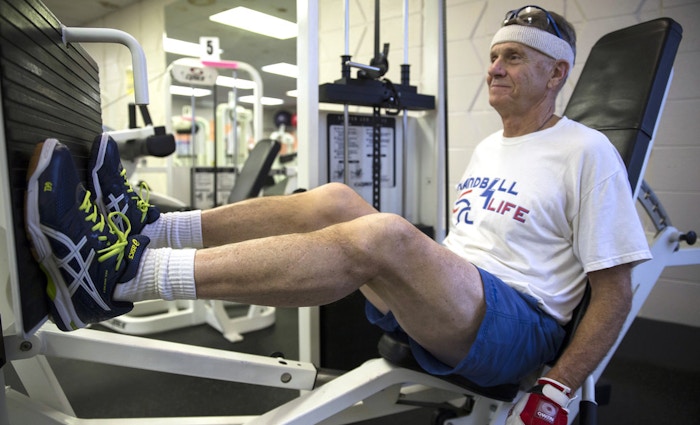
By JEN MURPHY From The Wall Street Journal
Of all the sports 70-year-old Bob Hammond played in his youth, handball is the one where he can still dominate, even after two knee replacements.
Mr. Hammond plays people half his age at his local YMCA and competes in tournaments around the country. He was introduced to the sport in 1969, during a stint as an administration specialist with the U.S. Army at Camp Long in South Korea.
“The general was a handball junkie,” Mr. Hammond recalls. “He even built a handball court at the base.” When Mr. Hammond returned home to South Bend, Ind., he found a court and hasn’t stopped playing.
Handball, like racquetball, is played on a 20-by-40-foot court. Players use a hand or a fist to serve and return the ball; they can hit it against six surfaces—floor, ceiling and all four walls. A rally is won when one player is unable to return the opponent’s shot to the front wall before it touches the floor twice, or when the player returns the ball so that it hits the floor before hitting the front wall.
The game may be played with two, three or four players. Points are scored only by the serving side, and games are played to 21 points. The best two out of three games wins the match.
Mr. Hammond grew up playing basketball, football and baseball. But handball is the sport he found most challenging, he says. “It also made me better at every other sport because it requires tremendous hand-eye coordination,” he says. “You have to become somewhat ambidextrous to play the game competitively.”
Mr. Hammond, who is also a lifelong runner, began to have knee trouble when he turned 50. He had one knee replaced in 2008 and the other in 2011. His doctor told him his marathon days are over, but handball would be OK if he kept up a regular strength routine for his quads and hamstrings. “Handball is more of a gliding and shuffling on the court, rather than constant pounding,” Mr. Hammond says.
The father of four sons ages 38 to 45, Mr. Hammond runs LS Manufacturing, a maker of plastic thermoforming packaging, with three of his sons, whom he also enlists as handball partners. Each December he and his second youngest son Phil travel to compete in the Milwaukee Handball Classic. “My dad had me playing handball by the age of 9,” says Phil Hammond. “It wasn’t the coolest sport, but it helped me excel in other sports.”
“The game works all of your muscles,” the son says. “It’s kept my dad in incredible shape. At 70, he has the body that I am sure most 20-year-olds would love to have.”
The Workout
Mr. Hammond plays handball four to five days a week, usually for at least an hour. He says it’s difficult to find partners his age. “Everyone is five to 20 years younger than me,” he says. “But I’m a handball junkie so I’ll play anyone to get my fix.”
If he’s in a bind, Mr. Hammond will practice alone. “It takes a few years and constant practice to make your nondominant hand, which in my case is my left hand, do what my right hands does.” When he doesn’t have a partner, he’ll repeatedly throw and hit the ball against the wall with his left hand to develop his coordination.
A typical match, lasting anywhere from 20 to 40 minutes, provides the ultimate cardio workout, Mr. Hammond says. A study at the University of Utah found handball players burned an average of 751 calories an hour, compared with 644 calories an hour for racquetball players.
A ball travels slower when hit with someone’s hand versus a racket, which means more running is needed to get to it. “It’s like doing suicide sprints for over an hour,” says Phil Hammond. His father says the sport has kept him mentally sharp, too. “It’s just as much a mental game as it is physical,” he says. “You’re constantly anticipating where the ball will go after each bounce.”
Two days a week Mr. Hammond goes to the gym at a local YMCA. “I try to use every weight machine,” he says. His circuit includes the leg press machine, calf machine, quad extension machine and hamstring curl machine, followed by the chest press, lat pull-down, shoulder press, triceps extension machine and biceps curl machine.
The Diet
“I’m not a health freak,” he says. Breakfast is oatmeal or whole grain toast followed by a doughnut a few hours later. Lunch is leftovers, and a midday snack is chips or a banana. He’ll eat a bowl of Shredded Wheat cereal before handball. He says he and his wife eat at home 90% of the time.
He occasionally has steak or a hamburger, but pork and pasta are the norm. He says he’d eat mashed potatoes and gravy every night if his wife let him. Her home-baked fruit pies are his favorite indulgence.
Cost & Gear
Mr. Hammond pays $59 a month for his YMCA membership. He buys volleyball sneakers by Asics, which retail for $100. He says the gum sole provides better traction on the court. “If I didn’t wear gloves, my hands would look like hamburger meat,” he says. His Owen padded handball gloves cost about $20. “When you have a ball whirring past your head at 100 miles an hour, protective goggles are essential,” he says.
